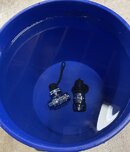You are using an out of date browser. It may not display this or other websites correctly.
You should upgrade or use an alternative browser.
You should upgrade or use an alternative browser.
Question Best way to clean a DIN 1 stage without getting water inside
- Thread starter TretaG
- Start date
Please register or login
Welcome to ScubaBoard, the world's largest scuba diving community. Registration is not required to read the forums, but we encourage you to join. Joining has its benefits and enables you to participate in the discussions.
Benefits of registering include
- Ability to post and comment on topics and discussions.
- A Free photo gallery to share your dive photos with the world.
- You can make this box go away
This discussion happens every time someone talks about rinsing first stages. I'll only say that lots of divers and lots of dive shops have collectively soaked their dust capped first stage millions of times without a problem. We've even been know to push the purge button on the seconds (gasp) as long as the first is held above the rinse water.
OTOH, there will always be people to tell you not to do it and they'll often supply pictures of corroded regs. Although somehow the outside of the regs are always a mess too which is not what you'd get from well-rinsed regs.
There's also the fact that you need to soak regs to really get rid of all the salt crystals. Rinsing is fine to clear the sand and get you to the next day's dive, but clean means a soak. Cenote/spring divers are excused here.
IMO, pressurizing the first stage only protects you from boneheaded moves likes soaking without the dust cap being in place. But if you can't concentrate enough to rinse a reg safely, adding pressurized gas to the mix changes a potential headache to a potential catastrophe.
OTOH, there will always be people to tell you not to do it and they'll often supply pictures of corroded regs. Although somehow the outside of the regs are always a mess too which is not what you'd get from well-rinsed regs.
There's also the fact that you need to soak regs to really get rid of all the salt crystals. Rinsing is fine to clear the sand and get you to the next day's dive, but clean means a soak. Cenote/spring divers are excused here.
IMO, pressurizing the first stage only protects you from boneheaded moves likes soaking without the dust cap being in place. But if you can't concentrate enough to rinse a reg safely, adding pressurized gas to the mix changes a potential headache to a potential catastrophe.
Scubapro dust caps are just dust caps, if you want to soak it unpressurized get a screw on cap that properly engages the DIN o ring.
This ^^^^ The standard "Push-ON" DIN caps that come with the regulator are crap. They don't seal at all.
rigel_canon
New
La mayoria de las veces, cuando tenemos corrosion dentro de las las primeras etapas, ( eso ocurre en todas), es debido al aire que suministra en compresor de carga, a los compresores y sus sistemas de decantacion y separacion de agua le cuesta mucho entregar aire 100 por 100 seco, por lo cual al cabo del tiempo y el uso, los reculadores presentan corrosion y depositos calcareos.No sé qué es el bloqueo hidráulico, pero la corrosión dentro del regulador debido a la entrada de agua es algo real.
Pavao
Contributor
- Messages
- 858
- Reaction score
- 625
This is only partially true.If you find a discarded sinter filter at the local dive shop you can try a small experiment. Fill it with water and it will hold it like a cup of tea without dripping any down through the other side. That sinter filter installed at the entry point or inlet in a 1st stage (whether Yoke or Din) is designed to let only pressurised air pass through.
So even if some water does leak into the inlet through the dust cap while it is soaking in a tub, it’s not going to pass through into the regulator innards.
View attachment 837392
Water won’t pass through it IMMEDIATELY, but it’s only a matter of time.
Do the experiment, grab a yoke retainer with the filter and star clip assembly, fill with water and let it sit over a piece of paper, all the water will sip through. Wether it passes through the filter or around it, I’m not sure, didn’t care to know the difference really as it wouldn’t matter. It’ll hold water for some time, I don’t remember how long it took, but once it passes through, all of it goes through, meaning that it isn’t a slow process, nothing will pass through for some time, but once it starts, then all of it passes quickly.
Well?????????No doubt, from salt water. But from fresh water, that got past the dust cap, while rinising?
Some one remind me to check on these in a month:
View attachment 837404
The Mk2 went in with an IP of 142psi, and the 2950 went in with 168psi.
iointerrupt
Contributor
Well?????????
Not a drop into the regulator: Rubber DIN Dust Caps: Leaky Nightmare, or Master Sealer?
ReminderNo doubt, from salt water. But from fresh water, that got past the dust cap, while rinising?
Some one remind me to check on these in a month:
View attachment 837404
The Mk2 went in with an IP of 142psi, and the 2950 went in with 168psi.
Look one post up...Reminder
Similar threads
- Replies
- 29
- Views
- 2,710
- Replies
- 2
- Views
- 364
- Replies
- 0
- Views
- 293
- Replies
- 19
- Views
- 1,012




